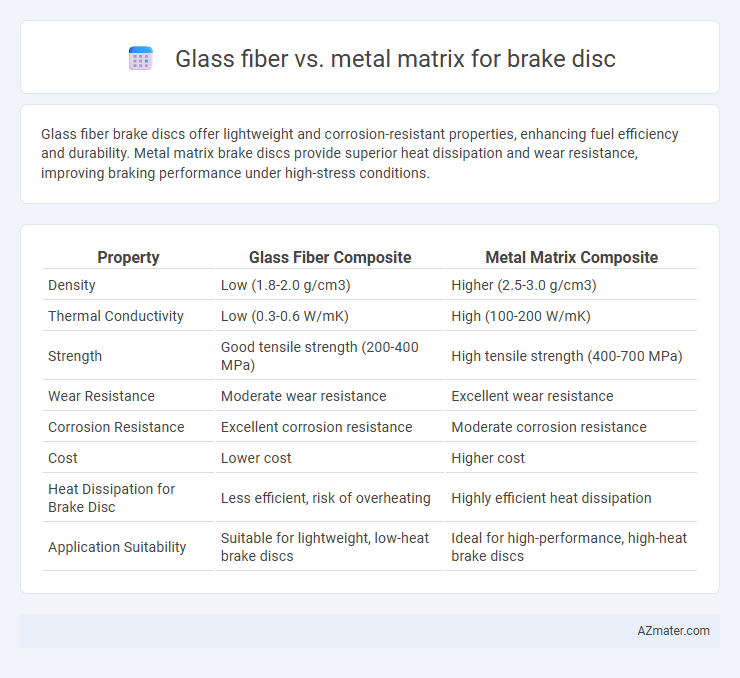Glass fiber brake discs offer lightweight and corrosion-resistant properties, enhancing fuel efficiency and durability. Metal matrix brake discs provide superior heat dissipation and wear resistance, improving braking performance under high-stress conditions.
Table of Comparison
| Property | Glass Fiber Composite | Metal Matrix Composite |
|---|---|---|
| Density | Low (1.8-2.0 g/cm3) | Higher (2.5-3.0 g/cm3) |
| Thermal Conductivity | Low (0.3-0.6 W/mK) | High (100-200 W/mK) |
| Strength | Good tensile strength (200-400 MPa) | High tensile strength (400-700 MPa) |
| Wear Resistance | Moderate wear resistance | Excellent wear resistance |
| Corrosion Resistance | Excellent corrosion resistance | Moderate corrosion resistance |
| Cost | Lower cost | Higher cost |
| Heat Dissipation for Brake Disc | Less efficient, risk of overheating | Highly efficient heat dissipation |
| Application Suitability | Suitable for lightweight, low-heat brake discs | Ideal for high-performance, high-heat brake discs |
Introduction to Brake Disc Materials
Brake discs require materials with high thermal conductivity, wear resistance, and mechanical strength for optimal performance. Glass fiber composites offer lightweight properties and corrosion resistance, making them suitable for reducing vehicle weight while maintaining adequate strength. Metal matrix composites provide superior heat dissipation and durability under extreme braking conditions, supporting enhanced thermal management and long service life.
Overview of Glass Fiber Composites
Glass fiber composites used in brake discs offer high strength-to-weight ratios and excellent thermal stability, making them suitable for high-performance braking systems. These composites consist of glass fibers embedded in a polymer matrix, providing enhanced corrosion resistance and reduced weight compared to traditional metal matrix materials. The improved energy absorption and durability of glass fiber composites contribute to longer service life and better performance under extreme conditions.
Introduction to Metal Matrix Composites
Metal Matrix Composites (MMCs) combine metal alloys with reinforcement materials like ceramics or fibers to enhance mechanical properties such as strength, stiffness, and thermal resistance. Compared to glass fiber composites, MMCs in brake disc applications offer superior high-temperature performance and wear resistance, essential for automotive braking systems. The integration of lightweight metals like aluminum or magnesium with ceramic reinforcements improves braking efficiency and durability under extreme operating conditions.
Mechanical Properties Comparison
Glass fiber composites exhibit high tensile strength and excellent corrosion resistance, making them lightweight alternatives for brake discs, while metal matrix composites (MMCs) provide superior thermal conductivity and enhanced wear resistance critical for high-performance braking applications. MMCs generally offer greater stiffness and fatigue resistance under cyclic loading compared to glass fiber composites, which may suffer from lower modulus and impact durability. The mechanical properties of MMC brake discs enable better heat dissipation and prolonged service life in demanding environments, whereas glass fiber composites prioritize weight reduction and corrosion immunity.
Thermal Conductivity and Heat Resistance
Glass fiber brake discs exhibit lower thermal conductivity compared to metal matrix composites, resulting in slower heat dissipation during braking. Metal matrix brake discs, particularly those reinforced with aluminum or ceramic particles, offer superior heat resistance and enhanced thermal conductivity, enabling more efficient heat management and reduced thermal deformation. High thermal conductivity in metal matrix composites ensures rapid heat transfer away from the friction surface, improving overall brake performance and durability under extreme operating conditions.
Weight and Density Analysis
Glass fiber brake discs offer significantly lower density, typically around 2.5 g/cm3, compared to metal matrix composites (MMCs) which range from 3.5 to 4.5 g/cm3, resulting in substantial weight reduction beneficial for vehicle efficiency. The lightweight nature of glass fiber composites reduces unsprung mass, enhancing braking response and fuel economy. Metal matrix brake discs, while heavier, provide superior thermal conductivity and mechanical strength but at the cost of increased weight and density.
Durability and Wear Performance
Glass fiber brake discs offer superior corrosion resistance and reduced weight, enhancing durability under moderate thermal stress. Metal matrix composite brake discs exhibit exceptional wear resistance and thermal conductivity, maintaining structural integrity during high-temperature operation. The enhanced toughness and heat dissipation of metal matrix materials result in longer service life and consistent braking performance compared to glass fiber alternatives.
Cost and Manufacturing Considerations
Glass fiber brake discs offer significant cost advantages due to lower raw material prices and simpler composite manufacturing processes compared to metal matrix composites. Metal matrix brake discs, while more expensive, provide superior thermal conductivity and wear resistance but require complex casting or powder metallurgy techniques that increase production costs. Manufacturing considerations for glass fiber include lower processing temperatures and reduced tool wear, whereas metal matrix components demand precise thermal management and machining, impacting overall cost efficiency.
Environmental Impact and Sustainability
Glass fiber brake discs offer advantages in environmental impact due to their lightweight nature, which reduces vehicle fuel consumption and CO2 emissions during operation. Metal matrix brake discs, typically aluminum or magnesium based, require intensive mining and energy processes, resulting in higher embedded carbon footprints. Recyclability favors metal matrix composites because metals can be efficiently reclaimed and reused, whereas glass fiber composites often face challenges in recycling and end-of-life disposal, influencing sustainability considerations.
Conclusion: Choosing the Right Material for Brake Discs
Glass fiber composites offer superior corrosion resistance and weight reduction while providing adequate thermal insulation for brake discs, enhancing overall vehicle performance and fuel efficiency. Metal matrix composites, typically aluminum reinforced with ceramic fibers, provide higher thermal conductivity and improved mechanical strength, making them suitable for high-performance braking systems requiring efficient heat dissipation. Selecting the right material depends on specific application needs, where glass fiber excels in lightweight, corrosion-resistant environments, and metal matrix composites dominate in high thermal load and mechanical stress conditions.

Infographic: Glass fiber vs Metal matrix for Brake disc
 azmater.com
azmater.com